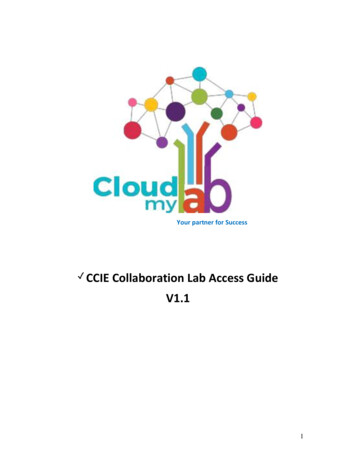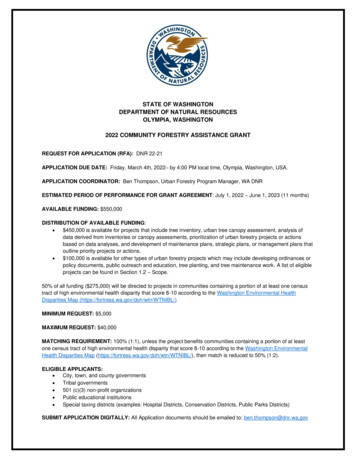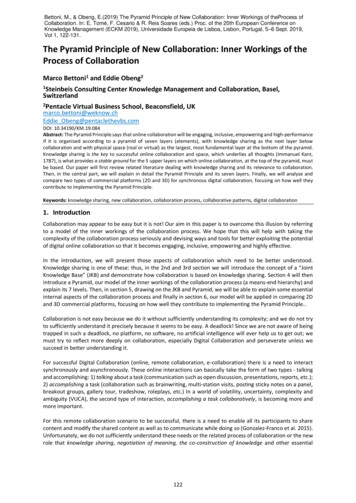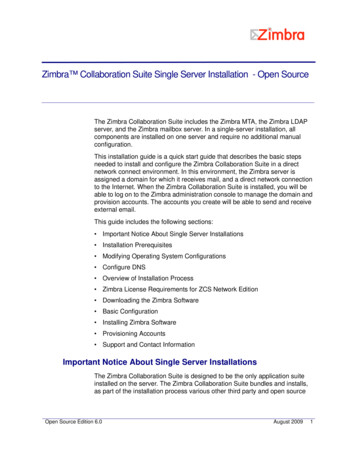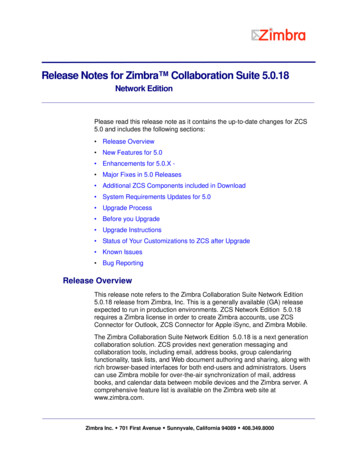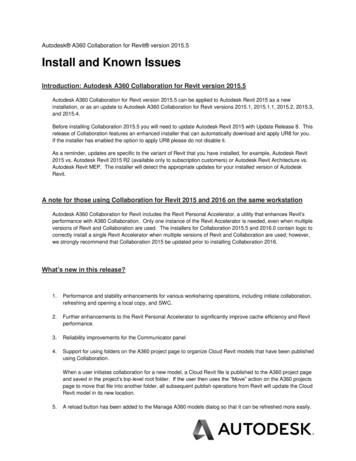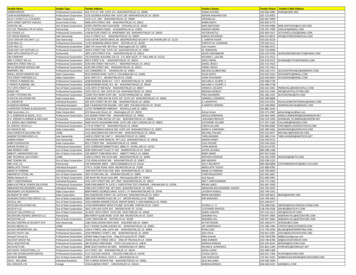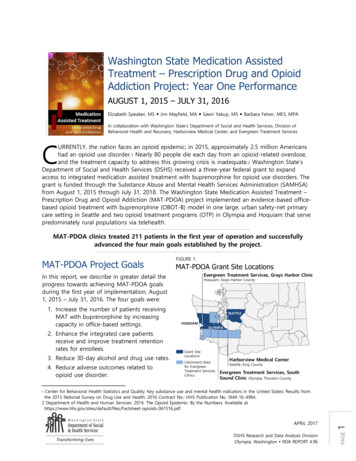
Transcription
Washington State Medication AssistedTreatment – Prescription Drug and OpioidAddiction Project: Year One PerformanceAUGUST 1, 2015 – JULY 31, 2016Elizabeth Speaker, MS Jim Mayfield, MA Sawir Yakup, MS Barbara Felver, MES, MPAIn collaboration with Washington State’s Department of Social and Health Services, Division ofBehavioral Health and Recovery; Harborview Medical Center; and Evergreen Treatment ServicesCURRENTLY, the nation faces an opioid epidemic; in 2015, approximately 2.5 million Americanshad an opioid use disorder.1 Nearly 80 people die each day from an opioid-related overdose,and the treatment capacity to address this growing crisis is inadequate.2 Washington State’sDepartment of Social and Health Services (DSHS) received a three-year federal grant to expandaccess to integrated medication assisted treatment with buprenorphine for opioid use disorders. Thegrant is funded through the Substance Abuse and Mental Health Services Administration (SAMHSA)from August 1, 2015 through July 31, 2018. The Washington State Medication Assisted Treatment –Prescription Drug and Opioid Addiction (MAT-PDOA) project implemented an evidence-based officebased opioid treatment with buprenorphine (OBOT-B) model in one large, urban safety-net primarycare setting in Seattle and two opioid treatment programs (OTP) in Olympia and Hoquiam that servepredominately rural populations via telehealth.MAT-PDOA clinics treated 211 patients in the first year of operation and successfullyadvanced the four main goals established by the project.MAT-PDOA Project GoalsFIGURE 1.MAT-PDOA Grant Site LocationsEvergreen Treatment Services, Grays Harbor ClinicIn this report, we describe in greater detail theprogress towards achieving MAT-PDOA goalsduring the first year of implementation, August1, 2015 – July 31, 2016. The four goals were:1. Increase the number of patients receivingMAT with buprenorphine by increasingcapacity in office-based settings.2. Enhance the integrated care patientsreceive and improve treatment retentionrates for enrollees.3. Reduce 30-day alcohol and drug use rates.4. Reduce adverse outcomes related toopioid use disorder.Hoquiam, Grays Harbor CountySEATTLEHOQUIAMOLYMPIAGrant SiteLocationsCatchment Areafor EvergreenTreatment ServicesClinicsHarborview Medical CenterSeattle, King CountyEvergreen Treatment Services, SouthSound Clinic Olympia, Thurston CountyCenter for Behavioral Health Statistics and Quality. Key substance use and mental health indicators in the United States: Results fromthe 2015 National Survey on Drug Use and Health. 2016 Contract No.: HHS Publication No. SMA 16-4984.2 Department of Health and Human Services. 2016. The Opioid Epidemic: By the Numbers. Available t-opioids-061516.pdf.DSHS Research and Data Analysis DivisionOlympia, Washington RDA REPORT 4.96PAGEAPRIL 201711
GOAL 1Increase MAT capacity and number of patients servedTo achieve Goal 1—increase MAT capacity and the number of patients receiving MAT in WashingtonState—MAT-PDOA project staff established four objectives: 1) increase the number of serviceproviders offering MAT; 2) train staff at designated sites to use evidence-based practices toimplement MAT with buprenorphine; 3) increase the number of patients receiving MAT for opioid usedisorder (OUD); and 4) develop billing protocols for MAT.Increase the number of MAT providers. To expand the number of service providers offering MAT,the project identified counties with a high need for OUD treatment based on opioid treatmentadmissions, OUD related deaths and crime lab cases involving opioids. In the selected counties, thesemeasures increased significantly in the past decade (Table 1). Three clinical sites were selected toserve these counties: an urban, safety net primary care clinic within Harborview Medical Center (HMC)in Seattle and two Evergreen Treatment Services opioid treatment programs (OTP): South SoundClinic (SSC) in Olympia and Grays Harbor Clinic (GHC) in Hoquiam. HMC was selected to expand theirexisting capacity for OBOT-B and the ETS OTPs previously only offered methadone, and were selectedto implement OTP/OBOT-B model with telehealth. The ETS clinics serve a predominantly rural fivecounty region in western Washington (Figure 1).TABLE 1.Opioid Risk Profiles for Counties Served by MAT-PDOA ClinicsCountyGrays HarborKingLewisMasonPacificThurstonState AveragePublicly Funded OpioidTreatment AdmissionsDeaths Attributedto Any OpiateCrime Lab Cases InvolvingAny OpiateAnnual Rate per 100,0002002-04 2011-13% ChangeAnnual Rate per 100,0002002-04 2011-13% ChangeAnnual Rate per 100,0002002-04 2011-13% 325.3%295.3%122.6%-33.6%85.6%SOURCE: University of Washington: Alcohol and Drug Abuse Institute. 2015. Opioid trends across Washington State. ADAI-IB 2015-01.See: .pdf. NOTE: Pacific County data not available for deaths attributed to any opiate.Training Staff in Evidence Based MAT. All project sites hired and trained staff using grant funds.Each clinic hired a nurse care manager (NCM) and program manager to assist with grantimplementation. At the end of year one, all nurse care managers were hired and ETS was stillrecruiting a second program manager. HMC already had physicians waivered 3 to provide MAT; ETSrecruited one addiction psychiatrist to serve patients at both ETS sites via telehealth. The clinicsimplemented: 1) evidence-based MAT with buprenorphine/naloxone; 2) Massachusetts Office-BasedOpioid Treatment with Buprenorphine (OBOT-B) model; and 3) a promising practice, The JohnsHopkins School of Medicine Collaborative Opioid Prescribing (CoOP) model of OTP/OBOTcoordinated care. Ten staff between the three clinics was trained on the three models. ETS staff, whoserve rural communities, were also trained on telehealth to deliver MAT.HMC increased the number of MAT waivered physicians to 21 in year one, up from seven in the AdultMedicine clinic prior to MAT-PDOA implementation. At the close of year one, HMC had trained 31medical staff on the model, including residents, NCMs, and waivered physicians. HMC plans toTo prescribe or dispense buprenorphine, a licensed physician must apply for a waiver with the Drug Enforcement Agency andcomplete eight hours of training specific to dispensing controlled substances.PAGE23Washington State Medication Assisted Treatment – Prescription Drug and Opioid Addiction Project:Year One Performance, AUGUST 1, 2015 – JULY 31, 2016DSHS
conduct more training in year two. During year one ETS clinics shared one physician via telehealth.Due to patient capacity issues inherent in sharing one physician between two sites, ETS continued tobuild partnerships with other physicians and healthcare agencies to expand MAT at those clinics. Atthe end of year one, ETS recruited a second, part time MAT-waivered physician and trained two NCMs.Increase the Number of Patients receiving MAT. The MAT-PDOA project plans to serve 776patients over three years, 204 patients in the first year. By the end of year one, the project clinicsscreened 239 patients for enrollment in MAT. Of those 239 patients, 211 enrolled in treatment andreceived their first dose of buprenorphine: HMC enrolled 76, ETS SSC enrolled 74, and ETS GHCenrolled 61. The patients enrolled in MAT were predominately white (80 percent), more likely to bemale (58 percent) and aged 26 to 35 (41 percent) (Figure 2).FIGURE 2.WA MAT-PDOA Enrolled Patient DemographicsTOTAL PARTICIPANTS 211GENDERAGE DISTRIBUTIONRACE/ETHNICITYWhite Only, 80%Non-HispanicFemaleMINORITY DETAILHispanic/LatinoMaleBlack/African American42% 58%American Indian/Alaska 25 26-35 36-45 46-5514%8%20%7%Other*4%3%5%*Includes multiple races.56 NOTE: Gender is unreported for one patient. Race is unreported for two patients.The majority (65 percent) of patients enrolled in MAT-PDOA were not in any other substance usedisorder treatment prior to enrollment. Seventeen percent of patients were already receiving MATwith buprenorphine or methadone. ETS partnered with local detoxification agencies for patients whoare placed on a waiting list for treatment. Eighteen percent of patients received detoxification servicesprior to enrollment in MAT-PDOA (Figure 3) and were inducted on buprenorphine prior to theirtreatment start date.FIGURE 3.Treatment Engagement Prior to MAT-PDOA InductionReceiving Methadone 1%TOTAL PARTICIPANTS 211n 1Not in TreatmentDetoxn 138n 3865%18%ReceivingBuprenorphine16%n 34Billing Protocols for MAT. The MAT-PDOA project is collaborating with Washington StateRDADSHS Research and Data Analysis DivisionOlympia, WashingtonPAGE3agencies–the Department of Health and Health Care Authority (Medicaid)—to develop billingprotocols for MAT to improve long-term sustainability and encourage statewide dissemination ofMAT. When the MAT-PDOA project began, billing codes were available for medical clinics but notOTPs. Through the efforts of this project and others, billing rules were amended in January 2016 soOTPs could receive reimbursement for MAT services. HMC has successfully billed and thereimbursement rate allowed HMC to hire an additional registered nurse and medical assistant to helpcoordinate MAT OBOT care. Given ETS is an OTP, long term sustainability will depend on contracting
with managed care organizations (MCOs) that handle Medicaid and third party insurance claims.Securing these contracts has presented some challenges, but ETS has draft contracts with five of theMCOs and hopes to finalize them prior to the end of grant funding. However, even with the contractsin place, the reimbursement rate for OTPs is much lower than what medical clinics can receive. Thereduced rate will present long term sustainability challenges for OBOT in OTPs.GOAL 2Enhance Level of Integrated Care and Improve Retention RatesTo meet this goal, three objectives were developed: 1) increase access to primary care, mental healthand social services, and recovery supports; 2) improve MAT retention rates for enrollees; and 3)improve electronic health record-keeping to better track treatment plans and adherence to treatment.Increase access to services. All three MAT-PDOA clinics routinely provide or refer patients tomedical, mental health, social and recovery services as needed. Primary medical care is provided to allHMC patients and ETS sites refer patients to primary care as needed. All sites routinely screen forHIV, viral hepatitis, and sexually transmitted infections, and if positive, HMC creates care plans withpatients and ETS refers patients for further assessment and care. Project clinics also routinely referpatients to dental services, wound clinics, transportation services, detoxification, mental healthservices, employment and housing assistance programs, shelters, and intensive outpatient or inpatienttreatment for substance use disorders.Depression, anxiety and post-traumatic stress disorder (PTSD) screening is routine upon enrollment inMAT-PDOA using the Patient Health Questionnaire 9 (PHQ-9), the Generalized Anxiety Disorder 7(GAD-7), and the PTSD CheckList-Civilian (PCL-Civilian), respectively. Screening for the presence ofmental health disorders is particularly critical given that co-morbidity for substance use and mentalhealth disorders is common4. Among enrolled patients screened, 79 percent (Figure 4) had at leastone mental health disorder and 59 percent had more than one mental health disorder. 5 6FIGURE 4.Mental Health Screen Results at IntakeTOTAL PARTICIPANTS %61%64%39%HMCn 60SSCGHCHMCSSCGHCn 65n 47n 53n 64n 56Moderate to Severe DepressionModerate to Severe AnxietyHMCn 61SSCGHCn 67n 59Moderate to SeverePost Traumatic Stress DisorderLucenko, B.A., Mancuso, D., Felver, B.E.M., Yakup, S. 2010. Co-occurring mental illness among clients in chemical dependencytreatment. Washington State Department of Social and Health Services: Research and Data Analysis. Report 4.82.5 A PHQ9 or GAD7 score of 10 or higher indicates moderate to severe depression and anxiety. A PCL-Civilian score of 30 or higherindicates moderate to severe PTSD. Patients scoring in the moderate to severe ranges were considered to have screened positive.6 Patients with only two mental health screens completed were included in the denominator if the outcome of the two completedscreens were both negative or if they scored positive on both completed screens.PAGE44Washington State Medication Assisted Treatment – Prescription Drug and Opioid Addiction Project:Year One Performance, AUGUST 1, 2015 – JULY 31, 2016DSHS
Improve Retention Rates. The research literature on OUD treatment programs cites a 50 percentretention rate for persons who begin opioid treatment.7 In year one, MAT-PDOA clinic retention rateswere 77 percent (Figure 5).8 For patients still enrolled in MAT-PDOA at the close of year one, theaverage number of days in treatment was 112 days. Patients that left the program averaged 76 daysin treatment. The top three reasons for leaving treatment was inability for the clinic to locate patientsthat miss appointments, patient deciding to end treatment, or being referred to another program.Three patients returned to treatment after having left.Electronic Health Records. HMC uses their electronic health record system, Epic, to documentpatient outcomes and create customized reports for monitoring treatment plans and adherence toMAT. The ETS clinics’ electronic health record has not been adapted to track MAT; therefore anadditional patient log is used to manually track treatment adherence at those clinics. Additionally, allthree sites use the Washington State Prescription Monitoring Program (PMP) to look up incomingpatient prescription drug histories. Clinics, however, report the PMP to be cumbersome and the lag inreporting to be restrictive.FIGURE 5.MAT-PDOA Year One Retention by ClinicTOTAL PARTICIPANTS 211Harborview Medical CenterStill Enrolled78%TOTAL ENROLLED 76Discharged22%Evergreen Treatment Services – South Sound ClinicStill Enrolled73%Evergreen Treatment Services – Grays Harbor ClinicStill Enrolled82%TOTAL ENROLLED 74Discharged27%TOTAL ENROLLED 61Discharged18%GOAL 3Reduce 30 Day Alcohol and Drug Use RatesSAMHSA requires the MAT-PDOA project to conduct the Government Performance and Results Act(GPRA) survey with all participants.9 The survey is a self-report tool that asks participants about past30 day alcohol and drug use; housing and employment; criminal justice involvement; physical, socialand mental health. The survey is conducted for each patient at enrollment (intake) and six monthsafter the enrollment date (follow-up). To understand changes in patients’ alcohol and drug use overtime, patients were asked how many days in the past 30 days they used the following substances:alcohol, cocaine, marijuana, prescription opioids, heroin, methamphetamine, downers/sedatives,hallucinogens and inhalants.10Alford, D.P., LaBelle, C.T., Kretsch, N., Bergeron, A., Winter, M., Botticelli, M., Samet, J.H. 2011. Five Year Experience with CollaborativeCare of Opioid Addicted Patients using Buprenorphine in Primary Care. Archives of Internal Medicine; 171(5): 425-431. DOI:10.1001/archinternmed.2010.541.8 Patients were considered retained in treatment if they were still enrolled in the program on July 31, 2016.9 The GPRA survey instrument is at is gpra client outcome instrument final.pdf.10The GPRA survey is descriptive only and our analyses do not include a comparison group; therefore, these results should not be usedto describe the net impact of MAT.RDADSHS Research and Data Analysis DivisionOlympia, WashingtonPAGE57
With respect to opioids, significantly fewer patients reported any use at follow-up.11 Prior totreatment engagement, 65 percent of all patients reported using opioids in the past month; at followup only 16 percent reported opioid use. As noted in Figure 3, 35 percent of all patients enrolling intreatment were coming from another treatment program or from detoxification with a buprenorphineprescription. At intake, 42 percent of patients reported using heroin and 35 percent reported usingprescription opioids illicitly. By the six-month follow-up, heroin use declined to 13 percent and illicitprescription opioid use dropped to six percent, according to self-reports (Figure 6).While the focus of MAT-PDOA is to reduce illicit opioid use, it is useful to report other substance usepatterns associated with treatment. Reported alcohol use rates declined (22 percent to 20 percent),but the change was not statistically significant. Similarly, most other reported drug use declinedslightly from intake to follow-up, but the declines were not statistically significant. Methamphetamineuse, however, had significant declines in reported use at intake and follow-up (19 percent to 9percent, respectively).Compared to intake, patients reporting any alcohol or illicit drug use reported fewer days ofsubstance use in the month prior to follow-up. Self-reported illicit drug use significantly declinedfrom 25.5 days to 15.5 days in the past month. Similar trends were found across all opioid categoriesand all were statistically significant: any opioid use declined by 14.2 days, heroin use declined by 11.9days, and illicit prescription opioid use declined by 10.6 days (Figure 7). Alcohol use days wererelatively unchanged (5.7 to 5.3 days). All other drug categories reported either had small,insignificant declines in days used or remained constant from intake to follow-up.Finally, patients were also asked about injection drug use (IDU) during the past 30 days. IDU wasreported by nearly a third (31 percent) of all enrolled patients at intake. At follow-up, the selfreported rate of IDU was nine percent.FIGURE 6.Self-Reported Opioid Use, Past 30 DaysTOTAL PARTICIPANTS 15262% 74%Intake42% 69%35%Intake 83%Intake16%Follow-UpAny Illicit Opioid Use6%13%Follow-UpHeroin UseFollow-UpIllicit Prescription Opioid UseNOTE: Heroin and Illicit Opioid Use are not mutually exclusive. Statistically significant at p .0001.less than .05 are considered statically significant. Patients not reporting illicit opioid use were either already in treatment,given a buprenorphine prescription upon completion of detoxification, or using another prescription opioid as prescribed.PAGE611P-valuesWashington State Medication Assisted Treatment – Prescription Drug and Opioid Addiction Project:Year One Performance, AUGUST 1, 2015 – JULY 31, 2016DSHS
FIGURE 7.Self-Reported Average Days of Drug Use, Past 30 Days25.5 66%24.6Intake 57%21.7Intake 55%Intake20.4 55%Intake15.5Follow-Up10.5Follow-Upn 106n 62n 94Any Drug Usen 24Any Opioidsn 649.89.9Follow-UpFollow-UpHeroinn 20n 54n 8Illicit Prescription OpioidsNOTE: Statistically significant at p .0001. Averages are based only on patients using drugs.GOAL 4Reduce Adverse Outcomes Related to Opioid Use DisorderOpioid use disorder is associated with several adverse outcomes including job loss, homelessness,deterioration of interpersonal relationships, criminal justice involvement, poor health, and death. TheGPRA intake and follow-up data were used to examine housing and employment status, criminaljustice involvement, death, and healthcare utilization.The experiences of individuals who completed both intakeFIGURE 8.Self-Reported Employment andand follow-up surveys (n 152) are summarized here.School Enrollment, Past 30 Days Housing and Employment. The majority of patients wereTOTAL PARTICIPANTS 152 39%43%Follow-Up31%Intakehoused at intake (93 percent) and follow-up (94 percent).At intake, 31 percent of enrolled patients reportedemployment, school enrollment or both. Significantly morepatients (43 percent) reported being employed or enrolledin school at follow-up (Figure 8).Criminal Justice Involvement. Criminal justiceinvolvement was defined as self-reported arrests, probationor parole, or awaiting charges, sentencing or trial. Criminaljustice involvement increased slightly over time (12 percentEmployed or in Schoolto 14 percent); however the change was not statisticallyNOTE: Statistically significant at p .01.significant.Opioid Related Overdose and Death. One death was reported in the follow-up period. The causeof death is unknown and the individual had discharged from treatment prior to the time of death.Future analyses of MAT-PDOA outcomes will examine overdoses or deaths related to opioid useamong grant participants using Washington State Department of Health and Medicaid records.Emergency Department Utilization. Patients were asked about their past 30-day utilization ofRDADSHS Research and Data Analysis DivisionOlympia, WashingtonPAGE7inpatient, outpatient or emergency department services for physical complaint, mental or emotionaldifficulties, or substance misuse. Significant reductions in inpatient (27 percent to 4 percent) andemergency department utilization (7 percent to 2 percent) were reported (Figure 9). Given patientsare enrolling in outpatient treatment services, outpatient utilization significantly increased from intaketo the six-month follow-up (43 percent to 72 percent).
FIGURE 9.Self-Reported Healthcare Utilization, Past 30 DaysTOTAL PARTICIPANTS 152 67%72%Follow-Up43%Intake27% 85%Intake4%7% ergency DepartmentNote: Statistical significance at p .001 for Inpatient and Outpatient utilization; and Emergency Department utilization (p .0348).SummaryThe Washington State MAT-PDOA project is meeting the goals established in the grant by: Increasing the number of patients receiving MAT by increasing capacity in office-based settings. Enhancing the integrated care MAT-PDOA patients receive and improving treatment retentionrates for MAT-PDOA enrollees. Reducing 30-day alcohol and drug use rates of MAT-PDOA patients. Reducing adverse outcomes related to opioid use disorder.Three clinics expanded services for MAT with buprenorphine; providers not previously waiveredreceived training to provide MAT; 211 patients were enrolled into treatment; and billing procedureswere amended to better facilitate MAT sustainability. Participating clinics provided or referred patientsto medical services, behavioral health services, and social and recovery supports; and 77 percent ofpatients were retained in treatment for an average of 112 days, a retention rate higher than the 50percent originally targeted.Among 152 patients completing six-month follow-up surveys, illicit prescription opioid use, heroinuse, methamphetamine use, and injection drug use rates declined significantly. Alcohol and otherdrug use rates declined, but not significantly. One death was reported in year one, which occurredafter the patient had left treatment. More patients reported employment or school enrollment atfollow-up; patients also reported increases in outpatient services. Inpatient treatment and emergencydepartment utilization decreased from intake to follow-up. The majority of patients were housed (93percent) at intake and housing remained high at follow-up (94 percent). Criminal justice involvementdid not change significantly in the follow-up period.Findings in this report are preliminary. Further study is needed to understand the degree to which theOBOT-B model as implemented here improves short- and long-term outcomes. Future analyses usingadministrative data and statistically matched comparison groups will provide more definitive evidencewith respect to the impact of MAT-PDOA.REPORT CONTACT: Alice Huber, PhD, 360.902.0707VISIT US AT: lysisPAGE8We want to acknowledge the work of our colleagues throughout the research and data analysis division and our partnerprograms for all the work they do in serving Washington’s vulnerable populations.Washington State Medication Assisted Treatment – Prescription Drug and Opioid Addiction Project:Year One Performance, AUGUST 1, 2015 – JULY 31, 2016DSHS
Treatment - Prescription Drug and Opioid Addiction Project: Year One Performance AUGUST 1, 2015 - JULY 31, 2016 Elizabeth Speaker, MS Jim Mayfield, MA Sawir Yakup, MS Barbara Felver, MES, MPA Behavioral Health and Recovery; Harborview Medical Center; and Evergreen Treatment Services

